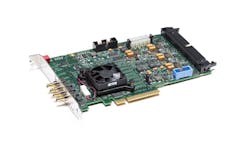BitFlow Overcomes Supply Chain Constraints to Maintain Frame Grabber Availability
WOBURN, MA—Supply chain disruptions, chip shortages and the rising cost of raw materials continue to bedevil the machine vision industry. System integrators are confronted with an experience once rare: no stock available at distributors and no idea when cameras, frame grabbers, computers, and other necessary accessories will come in.
To address this, BitFlow, Inc., a global manufacturer of CoaXPress and Camera Link frame grabbers headquartered outside Boston began to take steps to mitigate the impact of shortages on production at the onset of the pandemic. BitFlow's close relationships with its suppliers and partners of over 25 years enabled it to build in-house stock when shortages started becoming apparent. For example, Altera® FPGAs are key components of its cards. An FPGA is an integrated circuit with modifiable logic and memory blocks configurable in the field that help BitFlow customers reduce cost and improve design cycle times. To ensure a steady supply of FPGAs, BitFlow met with Altera to establish forecasting and lead times, ultimately resulting in purchasing additional stock.
Donal Waide, director of sales for BitFlow, notes that the company is experiencing stronger than expected demand yet has continued to reliably deliver its industry-leading products. "In the short term, lead times may, in some cases, be longer than we would like. For the most part, however, we have boards on hand and are able to go into new projects," he says.
Related
- Laser Scanning System uses BitFlow Frame Grabber to Improve Driver Visibility on Foggy Roads
- CoaXPress frame grabbers feature micro fan cooling
Although there are no silver bullets, Waide points to several steps BitFlow took to stay ahead of supply chain disruptions:
- Source alternative suppliers and review existing suppliers for common components.
- Increase collaboration and visibility with suppliers to determine their technology roadmaps to evolve product designs accordingly. Suppliers may drop the mature, less-profitable components used in legacy products in favor of newer technologies with higher margins.
- When reviewing suppliers, consider their global footprint and their ability to mitigate disruptions in one region with manufacturing capabilities in another.
- Remember that during shortages, suppliers determine who to support, not the other way around, underscoring the importance of strong relationships.
- If possible, move away from single-sourced parts.
Strained global supply chains have led to heightened demand for machine vision systems as manufacturers struggle to maximize yield from scarce components. Manufacturers are turning to machine vision to track goods throughout the production process with quality control measures that minimize waste and ensure compliance with customer and regulatory standards. In addition, with both parts and labor in short supply, plant maintenance is another area where machine vision is adding value, in particular when combined with AI. Cameras can be used to identify vibration issues before a failure occurs, for instance, or to detect wear on conveyor belts or leakage in remote pipes. Monitoring can be performed without service personnel shutting down a production line and opening cabinets or enclosures to check mechanical parts for wear. Keeping lines running yields an immediate production increase.
For more information, visit www.bitflow.
